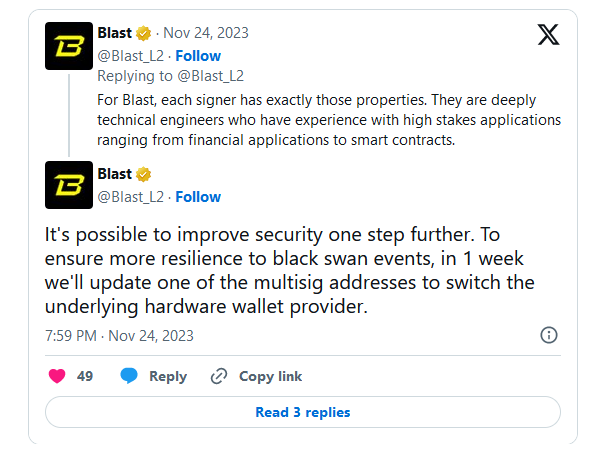Blast diversifies hardware wallet providers to reduce risks
The project’s founder also responded to community concerns about fraud due to the high promised returns

27.11.2023 - 13:38
384
3 min
0
What’s new? The Blast team responded to claims about the project from blockchain security experts. Earlier, Jarrod Watts of Polygon Labs and Yu Xiang of SlowMist stated that Blast is not a Layer 2 (L2) network, and is based on a multi-signature contract with instant update capability, controlled by five new anonymous addresses. Blast denied some of the claims, adding that it will update one of the addresses to fully diversify hardware wallet providers within a week to increase protection against the exploit.
What else is known? Watts and Xiang warned that users will not be able to withdraw funds without the approval of anonymous contract supervisors. In addition, the contract itself could instantly introduce malicious code updates to steal funds.
In response, Blast developers noted that there are no projects that are 100% secure. The ability to update the contract, in their opinion, is more of an advantage: it allows one to address vulnerabilities when they are discovered. At the same time, projects based on non-updated contracts will be forced to simply close down if there are bugs in the code, the developers explained.
The project’s representatives added that the keys to the signature-authorized addresses for contract renewal are stored in cold wallets managed by independent companies and are geographically separated from each other. Within a week, the wallet provider for storing one of the keys with signing rights will be changed, which guarantees security even if the hardware wallet is compromised, the team said. The issue is likely to be that each of the five keys will be stored in wallets from different providers.
The contract has a total of five signatories, requiring 3/5 signatures to make changes. Representatives of the project claim that all signatories are programmers with extensive experience in creating financial applications and smart contracts.
Blast was launched on November 21 by the team of the Blur NFT marketplace with $20 million backing from venture capital firms Paradigm, Standard Crypto, and eGirl Capital. The project is positioned as the only Ethereum-based L2 network with automatic returns in ETH and stablecoins. Thus, funds deposited by users are channeled into revenue-generating protocols such as Lido and MakerDAO.
For now, Blast is available in early access and by invitation only, and funds contributed by users cannot be withdrawn until February 24 next year. Paradigm criticized this launch tactic as it sets a bad precedent for other projects. However, Paradigm’s head of research Dan Robinson said that the Blast team includes world-class developers who are capable of creating a useful L2 solution for the entire cryptocurrency ecosystem.
Despite the temporary inability to withdraw funds, users have already transferred over $450 million to Blast in just six days after launch.
Blur and Blast founder Tieshun Roquerre, known by the nickname Pacman, also responded to concerns about Blast being a Ponzi scheme. He acknowledged that the promised returns may seem “too good to be true,” but they are not delivered by Blast itself but by partner projects, Lido and MakerDAO.
Lido is the largest ETH liquid staking protocol, and the yield for participating in the consensus mechanism in this case is determined by the Ethereum blockchain itself. As for MakerDAO, its yield is tied to US government short-term bonds.
Useful material?
Trends
As of January 21, the capitalization of this sector of the crypto market exceeds $519 billion
Jan 21, 2025
Market
The platform generated $9,5 million in revenue during the same time
Jan 20, 2025
Market
Shares of the Trust are designed to track the market price of XRP with fewer fees and expenses
Jan 17, 2025
Market
The asset will allow USDT to move seamlessly between different blockchains
Jan 17, 2025
Market
Earlier, the community criticized the project for its lack of transparency, which led to a sharp drop in the HYPE token price
Jan 8, 2025
Market
Rising US Treasury bond yields are negatively affecting risk assets
Jan 8, 2025










 Telegram
Telegram  Twitter
Twitter